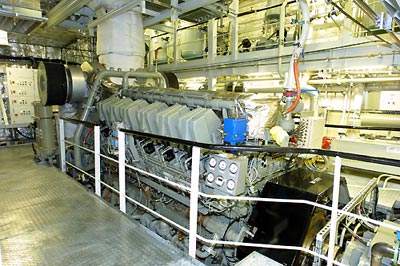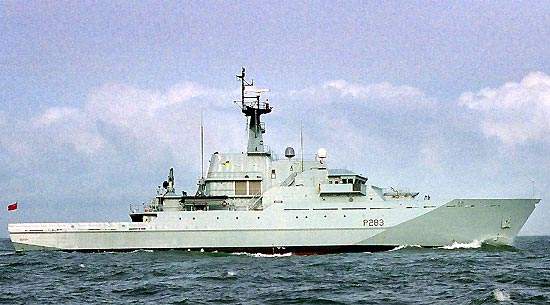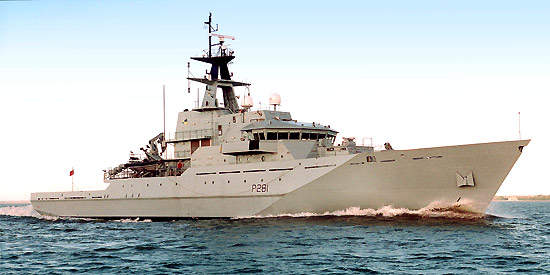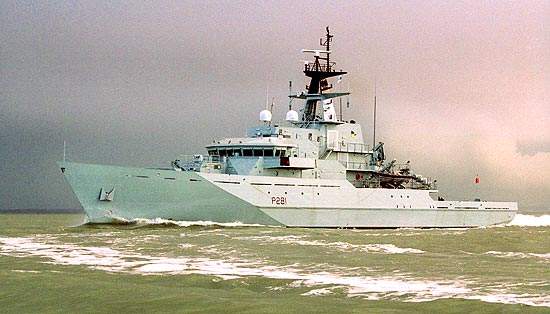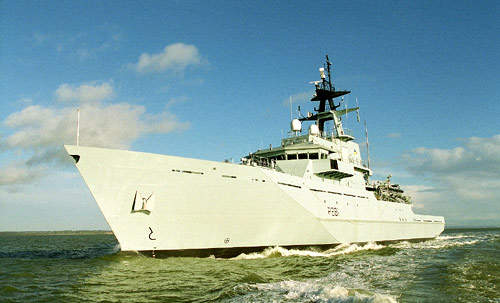The River-class offshore patrol vessels (OPVs) are in service with the UK Navy, securing the UK’s borders and protecting its interests abroad. The OPVs are deployed for fishery protection and other patrol missions.
The class comprises vessels manufactured in two batches. The first batch was built by Vosper Thornycroft Shipbuilding (now BAE Systems Naval Ships), while the second batch was built by BAE Systems Naval Ships.
The first three vessels in the River-class, HMS Tyne (P281), HMS Severn (P282) and HMS Mersey (P283), entered service in 2003. The vessels form Batch 1 of the River-class OPVs, which replaced five Island-class OPVs that entered service in 1979. The 1,260t Island-class vessels were transferred to the Bangladesh Navy.
The five Batch 2 vessels are named HMS Forth, HMS Medway, HMS Trent, HMS Tamar and HMS Spey.
Design and features of River-class OPVs
The River-class Batch 1 vessels are just under 80m in length and have a full load displacement of 1,700t. The design was carried out by Vosper Thornycroft, assisted by Three Quays Marine.
The hull design gives very comfortable sea-keeping characteristics, even in high sea states, and the 4,125kW engine gives a full load maximum speed of 20k in sea state 4. A semi-active stabiliser tank enables roll damping at all speeds, including when stationary. The vessels carry sufficient fuel, stores and water supplies for an endurance of 21 days.
The vessels are of steel construction in a double chine hull form. The fine form ram bow has a very low wave-making resistance, which gives fuel efficiency and comfortable sea-keeping characteristics.
The OPV typically has a complement of 28 but can accommodate a crew of 30 as well as a Royal Marine boarding party of 18, comprising 12 officers, 14 senior and 22 junior ratings. Modular cabins, prefabricated and outfitted by Vosper Thornycroft, are either single or double berth with en-suite facilities.
The working deck of HMS Tyne is sufficiently large to transport a number of smaller craft, wheeled or tracked light vehicles, or a landing craft, vehicle, personnel (LCVP) craft.
The working deck can accommodate up to seven containers, enabling the ship to carry additional stores, workshops, mine countermeasure support containers, a diving recompression container or medical facilities. A heavy crane of 25t capacity is fitted to handle standard containers.
The Batch 2 River-class OPV has a length of 90.5m and displacement of 2,000t. It features a flight deck that can accommodate a Merlin helicopter. The vessel can accommodate a crew of 45 as well as up to 50 Royal Marines.
Navigation and control
The River-class OPV has a Robertson AP9 MkIII autopilot and is fitted with an integrated navigation and communications suite supplied by Marine Electronics Supplies.
The navigation suite includes a SafeMarine electronic chart display, Kelvin Hughes Nucleus navigation radar operating at I-band, Leica MXXX420/2 global positioning system, Raytheon Annschutz gyro compass, Lilley and Gillie Sesterline Mk X magnetic compass, Fe700 echo sounder supplied by Furuno, Walker 7070 log and wind system, navigational telex (NAVTEX), and weather fax.
Communications equipment and sensors
The OPV is equipped with a Rhode and Schwarz military communications suite operating in high frequency (HF)/very high frequency (VHF) and ultra-high frequency (UHF) bands, Furuno maritime VHF communications set, INMARSAT-B satellite communications and global maritime distress and safety system (GMDSS) Area A3 military communications.
The Batch 2 vessels are fitted with Terma’s SCANTER 4100 radar system, which provides target detection and situational awareness, and Chess Dynamics’ Sea Eagle optronic director.
Inflatables
The vessel carries two Halmatic Jet Pacific 22 rigid inflatable boats (RIB). The River-class roll damping capability, provided by the semi-active stabiliser tank, is useful in RIB launch and recovery operations.
RIB launch and recovery can be carried out in wave conditions up to Sea State 5, with wave heights between 2.5m and 4m, using single-man operation, single-point lift davits. An RIB tracking system is also fitted.
Weapons carried by River-class patrol vessels
The Batch 2 vessels have a bigger main gun with a 30mm calibre, compared to the 20mm gun carried by the Batch 1 vessels. The armament of the Batch 1 OPV also includes two general-purpose machine guns (GPMGs).
Each Batch 2 vessel is equipped with an automated small calibre gun (ASCG) 30mm Bushmaster gun, two Mk 44 miniguns and four 7.62mm GPMGs. HTMS Krabi has a 76mm gun.
Propulsion and performance
The Batch 1 patrol vessel is powered by two Ruston 12 RK 270 medium speed diesel engines, rated at 4,125kW, 1,000rpm, which drive twin controllable pitch propellers.
The auxiliary power suite comprises three 250kW Caterpillar engines and Newgate Stamford alternators. There are three 250kW main generators plus an emergency generator. A VTC control and monitoring system is also fitted.
For berthing, station keeping and other fine control manoeuvrings, the vessel is equipped with a Veth Motoren VT bow thruster rated at 280kW.
The propulsion system on board Batch 2 vessels includes two MAN 16V diesel engines, two Wartsila CPP 5C10 controllable pitch propellers and a bow thruster.
The top speed of the Batch 2 vessel is 25k, while the Batch 1 OPV achieves 20k. The River-class OPVs have a range of 5,500 miles (8,851km).
The endurance of Batch 1 and Batch 2 vessels is 21 and 35 days, respectively.
Orders and deliveries
The UK Ministry of Defence placed a contract with Vosper for HMS Clyde, a modified Batch 1 vessel, to act as the Falkland Islands Patrol Vessel, in February 2005.
HMS Clyde, the fourth OPV, replaced the Castle-class HMS Leeds Castle and Dumbarton Castle OPVs.
It has an aft helicopter flight deck for up to Merlin-sized helicopters, a larger MSI-Defence Systems DS30B 30mm gun, BAE Systems Insyte combat data system, Terma Scanter 4100 I-band surveillance radar and Lockheed Martin Warship Electronic Chart Display and Information System (WECDIS) with WECDIS software from OSI Geospatial.
The OPV was commissioned in July 2007. It departed for the Falkland Islands in August 2007 and replaced HMS Dumbarton Castle.
HMS Clyde was decommissioned in December 2019 and replaced by HMS Forth, the first amongst the five Batch 2 OPVs.
BAE Systems received a £348m ($584m) contract from the UK Ministry of Defence (MoD) to build three new Batch 2 OPVs for the UK Royal Navy in August 2014. Two more Batch 2 OPVs, worth £287m ($362.57m), were ordered in December 2016.
HMS Forth was accepted by the UK MoD in January 2018 and arrived at its homeport of Portsmouth the next month. It was officially commissioned in April 2018.
The first steel of HMS Medway was cut in Glasgow in June 2015. The ship was commissioned in September 2019. The third Batch 2 vessel, HMS Trent, was commissioned in August 2020.
The fifth and final Batch 2 River-class ship, HMS Spey, arrived at the Royal Navy’s HM Naval Base Portsmouth in October 2020. The delivery of HMS Spey marked the end of construction of the five Batch 2 OPVs.
BAE Systems was awarded a five-year support and maintenance contract worth £22m ($36.2m) for the River-class OPVs in September 2013. The maintenance programme was carried out by BAE Systems in partnership with A&P Group.
The company secured a two-year extension to the contract, which involved maintenance work and repair packages to old and new River-class vessels.
HMS Severn was decommissioned after 14 years of service in October 2017. It was recommissioned in the Royal Navy in August 2021, as part of Brexit preparedness to support the protection of fisheries and UK waters. The recommissioning was done after a refit and regeneration.
The Royal Thai Navy procured a 90m OPV, named HTMS Krabi, which was built in Thailand under a design, technology transfer agreement with BAE Systems. Based on the River-class OPV, HTMS Krabi was launched in November 2011 and commissioned in 2013.
Thai shipbuilding company Bangkok Dock signed a contract with BAE Systems for the second 90m OPV in January 2016. BAE Systems agreed to assist the shipyard in the licenced construction of the vessel under the contract.
BAE Systems delivered three OPVs based on the design of the River-class ships to the Brazilian Navy between 2013 and 2014.




